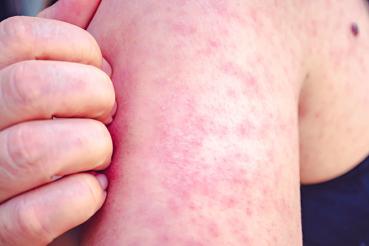At a recent health talk, Parul Bhatt, MD, a Rush Copley Medical Group pediatrician and mother herself, said, “It sounds easy but in practicality, it often is not.” To make it easier, she offers tips to parents to help their children start the school year off right, addressing the importance of a balanced diet, being active, getting enough sleep, immunizations and the appropriate use of electronics and screen time.
A Balanced Diet
Statistics show that nearly one in three school-age children and adolescents is overweight or obese. “We need to teach children now to be healthy adults,” Dr. Bhatt says. Although food pyramids have changed over the years, she recommends the Kid’s Healthy Eating Plate created by Harvard University, which is colorful and includes choices. “Put the picture on your refrigerator and talk about it with your kids,” she encourages. “Give them ownership and let them make choices.”
The school environment plays a role in influencing dietary behaviors, and Dr. Bhatt advises parents to look at what is offered inside and outside of the school cafeteria and encourage schools to stock healthy choices. If packing school lunches, she recommends choosing healthy options, including water (as opposed to soda) and dairy products.
Although nearly half of Americans skip it, breakfast has been associated with better memory, higher test scores, better attention span, decreased irritability, healthier body weight and improved overall nutrition. For rushed mornings, Dr. Bhatt suggests prepping for breakfast the night before, having dinner leftovers for breakfast or grabbing a granola bar, shake, fruit or low-sugar cereal. “Something is better than nothing,” she says.
Overall, she says parents can raise children to have a healthy relationship with food by teaching them what good choices are, allowing them to choose and modeling good choices.
Be Active
Physical activity is important, and Dr. Bhatt says at least 60 minutes a day of physical activity is recommended for children six years of age and older. This can be broken down into shorter blocks of time and can include activities like bicycle riding, rollerblading, jumping rope, soccer, dancing, hiking, and tag and other childhood games.
For children participating in sports, the pediatrician says annual baseline concussion testing is now required by some schools – and is worth considering even when not required. It is also important for children to know the signs of a concussion.
As children grow, many experience aches and pains at their growth plates. Dr. Bhatt says this is normal and can be treated with ice and anti-inflammatory medicine, but she recommends seeing a doctor if the pain lasts more than a few days.
Catch Up on Sleep
Sleep is important to overall good health, and children require nine to 12 hours of sleep a day while teens need eight to 10 hours. Dr. Bhatt recommends making sleep a family priority and encourages healthy sleep habits, like keeping a regular daily routine, staying active during the day to sleep better at night, and creating a sleep-supportive bedroom where children are encouraged to sleep rather than play. “Keep tablets out of bedrooms,” Dr. Bhatt recommends. “Turn off screens an hour before bedtime.”
Doctor Visits and Immunizations
Annual checkups are typically the only visit children and teens have with their pediatrician each year, and Dr. Bhatt says this is a chance for the physician to give the child a thorough physical exam that also addresses emotional, developmental or social concerns. It is also a time to get state-required immunizations as well as recommended non-required vaccines like the HPV, or human papilloma virus, vaccine, which protects against types of HPV that can lead to some forms of cancer.
Electronics: Media and Screen Time
According to statistics, three-quarters of teens own a smartphone, one-quarter are “constantly connected” to the internet, and 70 percent have a social media portfolio, including Facebook, Twitter and Instagram. In addition, four of five households have video games. To help monitor their children’s screen time, Dr. Bhatt recommends that parents:
- Develop, consistently follow and routinely revisit a family media use plan (the AAP plan can be found at www.HealthyChildren.org/MediaUsePlan).
- Address the types and quantity of media used and appropriate media behaviors. Place consistent limits on hours per day of media use as well as types of media used.
- Keep TVs, computers, smartphones and other electronic devices out of children’s bedrooms.
- Avoid exposure to devices or screens for one hour before bedtime.
- Discourage media during homework time.
- Designate media-free times and media-free locations in the home.
- Select and view media with children. This gives parents the opportunity to know what kids watch, see their reactions to it and talk about it. For younger children especially, this is more engaging and healthy than sitting in front of the TV alone.
- Talk to children about online citizenship and safety, including treating others with respect online and offline, avoiding cyberbullying and sexting, being wary of online solicitation and avoiding communications that can compromise personal privacy and safety. Make sure kids understand that people may not be who they say they are.
- Ask trusted adults to friend your children on social media.
Feeling Safe: Personal Safety Tips
Children who walk or bike to school should know safety rules, cross with a crossing guard when possible, and beware of distracted drivers. Dr. Bhatt encourages teaching children how to say no to an adult offering a ride, even if it’s an adult they know. “It’s no longer stranger danger,” she says – today, many children are assaulted by people they know.
When riding in a car, children – and all passengers – should always wear a seat belt. Children should use an age- or size-appropriate car seat or booster seat, riding in a car seat with a harness as long as possible before switching to a belt-positioning booster seat. Children are ready to graduate from harness seats when they reach the top weight or height allowed for the seat, their shoulders are above the top harness slots or their ears reach the top of the seat. They should then ride in booster seats until the vehicle’s seat belt fits properly – typically when they reach 4’9” in height and are between eight and 12 years of age. All children younger than 13 years of age should ride in the rear seat of vehicles. If a child must sit in the front seat, move the seat back as far as possible.
Talk and Listen
Dr. Bhatt says it’s important for children to eat well, stay active, get enough sleep, get regular checkups and limit their use of electronics. A Canadian study in the September 2019 issue of Pediatrics found that children who met sleep, screen time and physical activity recommendations reported lower levels of impulsivity.
Dr. Bhatt encourages parents to talk with their children and listen to their concerns, no matter how small. “If they share it, it means something to them,” she says. “And if you’re concerned, speak up. Talk to teachers, administrators and your pediatrician.”
Looking for more information to keep your children healthy? Dr. Bhatt recommends healthychildren.org as a good resource for families.



